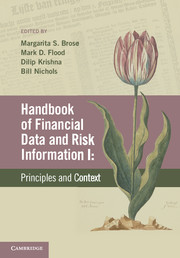Book contents
- Frontmatter
- Contents
- List of contributors
- Preface
- VOLUME I: PRINCIPLES AND CONTEXT
- PART I RISK MANAGEMENT CONTEXT FOR FINANCIAL DATA
- PART II REQUIREMENTS AND SOURCES FOR FINANCIAL RISK MANAGEMENT
- PART III REGULATORY DATA
- 10 A history of financial regulation in the USA from the beginning until today: 1789 to 2011
- 11 Data for microprudential supervision of US banks
- 12 Microprudential supervisory data in the USA: Securities and derivatives
- 13 Financial data and risk information needed for the European system of financial supervision
- 14 Data needed for macroprudential policymaking
- Index – Volume I
- References
10 - A history of financial regulation in the USA from the beginning until today: 1789 to 2011
from PART III - REGULATORY DATA
- Frontmatter
- Contents
- List of contributors
- Preface
- VOLUME I: PRINCIPLES AND CONTEXT
- PART I RISK MANAGEMENT CONTEXT FOR FINANCIAL DATA
- PART II REQUIREMENTS AND SOURCES FOR FINANCIAL RISK MANAGEMENT
- PART III REGULATORY DATA
- 10 A history of financial regulation in the USA from the beginning until today: 1789 to 2011
- 11 Data for microprudential supervision of US banks
- 12 Microprudential supervisory data in the USA: Securities and derivatives
- 13 Financial data and risk information needed for the European system of financial supervision
- 14 Data needed for macroprudential policymaking
- Index – Volume I
- References
Summary
Introduction
In the USA today, the system of financial regulation is complex and fragmented. Responsibility to regulate the financial services industry is split between about a dozen federal agencies, hundreds of state agencies, and numerous industry-sponsored self-governing associations. Regulatory jurisdictions often overlap, so that most financial firms report to multiple regulators; but gaps exist in the supervisory structure, so that some firms report to few, and at times, no regulator. The overlapping jumble of standards, laws, and federal, state, and private jurisdictions can confuse even the most sophisticated student of the system. At times, it can be unclear exactly who regulates whom, what rules apply in which instances, and where to turn for a resolution of these questions. This confusion occasionally inhibits innovation in the financial services industry and investments in some sectors of the economy. At other times, this confusion enables firms and investors to fly under the radar and profit from regulatory arbitrage. Whether this confusion promotes economic growth or causes economic instability is an open question.
How this confusion arose can be explained. The history of financial regulation is long but well documented. Responsibility for overseeing the financial services industry evolved in the USA during the last two centuries. Debate about how to regulate financial activity began at the Constitutional Convention in 1787 and continued unabated for two centuries. The political debate dictated the structure of the financial system; scholars have long noted this fact.
- Type
- Chapter
- Information
- Handbook of Financial Data and Risk Information IPrinciples and Context, pp. 385 - 425Publisher: Cambridge University PressPrint publication year: 2014
References
- 2
- Cited by



